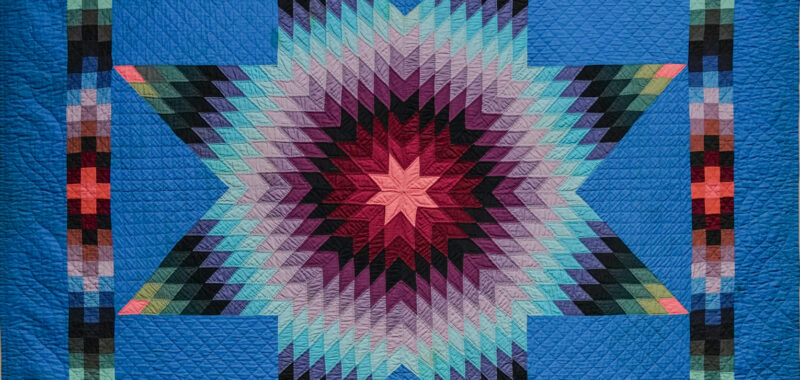WASHINGTON, DC — The vivid quilts displayed in Pattern and Paradox: The Quilts of Amish Women at the Smithsonian Museum of American Art (SAAM) are anything but plain. Though Amish communities are widely known for modest attire and a humble way of life isolated from the hustle of the contemporary world, the exhibition’s quilts reflect a kaleidoscopic mix of patterns and techniques. Accompanying wall texts delve into the apparent contradictions that are central to these eye-catching works, which exist at the intersections of tradition and innovation, conformity and individual creative expression, and the humble and the spectacular.
Pattern and Paradox comprises 50 quilts — drawn from a collection of 130 that art collectors Faith and Stephen Brown recently gifted to the museum — sewn in Amish settlements in Pennsylvania, Ohio, Indiana, and Illinois between the 1880s and the 1940s. This swath of time notably coincides with the rise of quilting in Amish communities. Though Amish people have lived in North America since the mid-18th century, the women didn’t widely adopt quilting until the end of the following century, after the general quilting craze of the mid-19th century had faded. As Janneken Smucker, quilt historian and fifth-generation Mennonite quilt-maker of Amish Mennonite heritage, writes in the exhibition catalog, “Once other Americans considered quilts old-fashioned, perhaps the craft became more appealing to the trend-reluctant Amish.”

Originally intended as bed coverings or keepsakes, the textiles were never envisioned by their creators as display pieces for museums or art collectors. But in the early 1970s, quilts made in Amish communities swelled in popularity among collectors, who drew visual parallels between these objects and the aesthetics of modernist abstraction; as a result, the quilts began to appear in prominent exhibitions at the Whitney Museum of American Art and SAAM’s Renwick Gallery. But this renown changed some Amish quilters’ relationship to their craft.
“The Amish themselves were discomfited by having made and, subsequently, possessing museum-worthy, valuable artworks — a notion entirely at odds with their intentions,” writes Leslie Umberger, the exhibition’s co-curator. Amish families began to “divest themselves” of these pieces. Like their diverse and ever-evolving patchwork traditions, the response among Amish quilters varied. Some families started buying bedding instead of sewing it, while others began making quilts specifically for customers outside the Amish community, as a means of income. Likewise, some quilters shifted their creative practices to favor color palettes that were less popular among collectors; others stayed the course and kept making the “old dark quilts.”

The works in Pattern and Paradox, made before Amish quilts entered the mainstream spotlight, radiate with bold, geometric slices of solid-colored fabrics, textured with precise quilting — the term for the tiny stitches that hold the layers of a quilt together, often with a decorative flourish. Organized around patchwork piecing patterns, blocks, and variations, the exhibit provides an overview of the eclectic styles and techniques Amish women employed during the late 19th century and the first half of the 20th century. The show also surfaces local aesthetic preferences popular in particular settlements. For instance, “strema” (or “bars”) quilts with wide vertical stripes are a classic pattern from Lancaster, Pennsylvania.
To make these highly varied quilts, women shared cardboard pattern templates and helped one another with tasks like piecing, marking, quilting, and binding their creations. Pieced together squares and rectangles, stripes, stars, triangles, and fan shapes tessellate across the resulting quilt tops. Composed of precise diamonds of fabric attached with technically tricky Y seams, “tumbling block” quilts pop with mind-boggling, cube-shaped optical illusions. “Center square” quilts, sometimes called “plain quilts,” forgo the complicated piecework in favor of open expanses of fabric that frame the impeccable hand-quilted motifs, including feathered wreaths, grapevines, cross hatching, and scallops.
Taken together, this collection of Amish quilts illuminates how patterns can serve as both the bones of tradition and a springboard for dynamic, ever-morphing creative experimentation — and even so-called “plain quilts” can dazzle.





Pattern and Paradox: The Quilts of Amish Women continues at the Smithsonian American Art Museum (8th and G Streets, Northwest, Washington, DC) through August 26. The exhibition was curated by Leslie Umberger and Virginia Mecklenburg, with support from Anne Hyland and Janneken Smucker.

